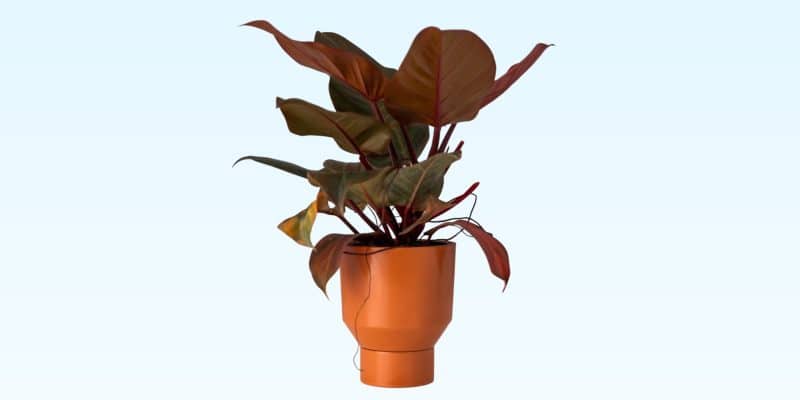Rich red hues and luscious, glossy leaves . . . did somebody say Imperial Red Philodendron?
No need to pack your bags for a tropical getaway — you can bring the vibrant energy of the tropics right into your living room!
This fabulous, compact specimen is not only gorgeous, but it’s also a pretty low maintenance plant. Bonus!
We’ll let you in on all the Philodendron Imperial Red care advice you need, including tips on watering, sunlight, and general maintenance. Let’s get growing!
Table of Contents
Imperial Red Philodendron Plant Care Guide
History, Habitat, and Characteristics
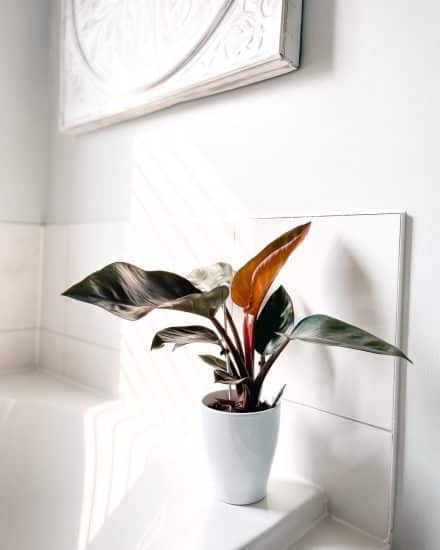
Imperial Red Philodendron (Philodendron erubescens ‘Imperial Red’) has made a name for itself in the plant world with its show-stopping dark green and red leaves and easy-going nature.
Hailing from the tropical rainforests of Central and South America, as well as the West Indies, this striking houseplant is a relatively new Philodendron erubescens hybrid, bred specifically for its beauty and low-maintenance appeal.
As a member of the ancient and diverse Araceae family, the Imperial Red Philodendron boasts large, glossy leaves that start off with hues of red and pink. These leaves eventually mature into a vibrant green with a hint of red, adding a touch of majesty to any room.
The regal name “Imperial Red” pays homage to the plant’s red-tinged stems and new growth. But don’t let the name deceive you — this colorful character won’t become a tyrant in your living space.
It usually reaches a maximum size of around three feet by three feet, with a wide and leafy body that loves to spread its leaves out. It looks great on tabletop displays and in larger open areas.
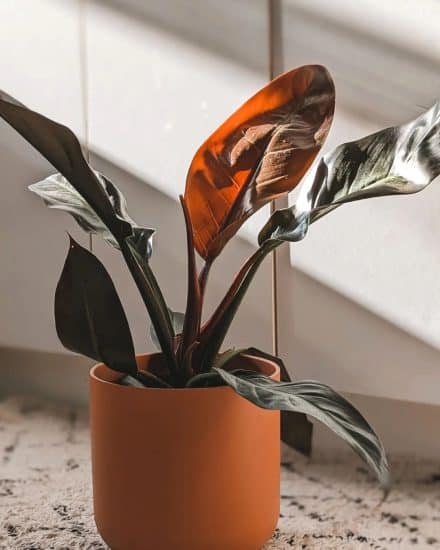
Although this royal beauty can grow up to roughly four feet in height, it’s a moderate grower and may experience slower growth in lower light conditions.
For those who prefer lighter shades of green, the Imperial Green Philodendron offers a more subtle, yet equally attractive, alternative.
Fun fact: The Araceae family, which includes the Imperial Red Philodendron, has been around for over 100 million years! Talk about a family tree with deep roots!
Light
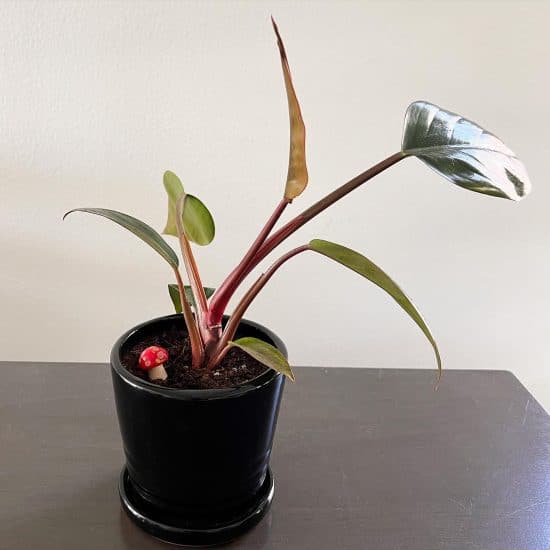
The Philodendron Imperial Red thrives in bright, natural light but leans more towards moderate light levels — think bright indirect sunlight This means you’ll want to shield it from direct sunlight, which could burn its dark green leaves.
Although it can tolerate lower light conditions, they may lead to slower growth, smaller leaves, and a loss of its deep green and dark red hues. I suggest positioning your plant a few feet away from a large east-facing window to promote healthy growth.
When your Philodendron Imperial Red light situation is lacking, you may observe slower growth, smaller leaves, and fading red color.
On the other hand, too much light could result in leaf burn (aka browning or scorching).
Our lighting tips:
- Target medium exposure, avoiding direct sunlight (nobody wants a burnt leaf!_
- Put your plant approximately a few feet away from a large east-facing window for optimal growth.
- Observe the plant’s color — a loss of red hues might mean it’s getting insufficient light.
- If natural light is inadequate, try using an artificial light source, like an LED grow light.
- If you spy signs of leaf burn, relocate the plant away from direct sun or use a sheer curtain to soften the sunlight.
Water
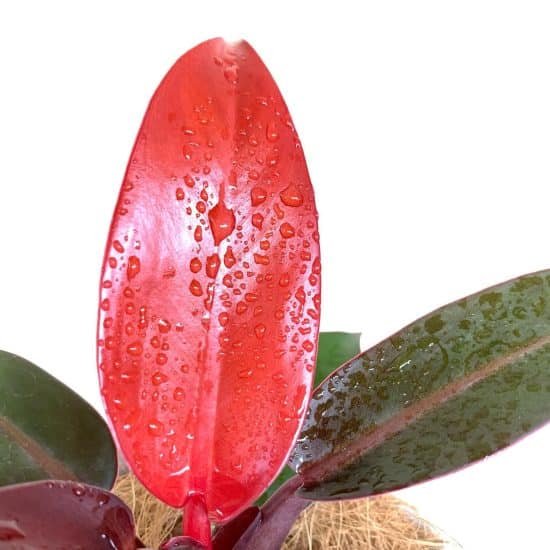
Finding the right balance in your watering routine is essential for a healthy Imperial Red Philodendron. Adjust the watering frequency according to the season (read: more in summer and less in winter), and allow the top two inches of soil to dry out between waterings.
In the winter, water your plant every 10-14 days, giving it a slow and thorough soak. During the summer, you may need to water as often as once a week. Always remember to let the plant get about 70% dry before quenching its thirst again. This method ensures consistent moisture and a happy plant.
When your Imperial Red Philodendron is not receiving enough water, you’ll notice the oldest leaves, usually at the bottom, turning yellow. Leaves may also start curling up.
To counteract this, increase your watering frequency and remove any dying leaves to prevent pests from feasting on them.
On the other hand, too much water can cause yellowing leaves throughout the plant, mushy stems, or constantly moist soil. If you see brown leaf tips followed by small brown and black spots on the leaves, rotting roots may be the culprit.
Reduce your watering frequency and allow the soil to dry out first.
Temperature and Humidity
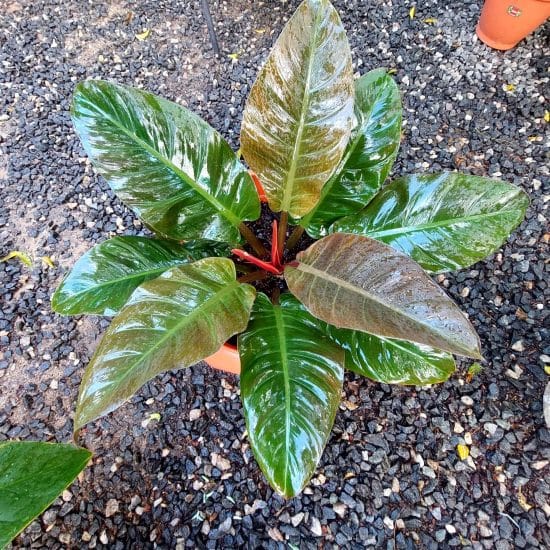
The temperature Philodendron Imperial Red prefers sits squarely in the realm of average home range (65°F to 80°F), but never lower than 53°F — these are tropical plants that enjoy warmth similar to their natural habitat.
Wilting or drooping leaves can be a sign that your plant isn’t getting enough warmth. On the other hand, loss of leaf color might indicate the temperature is too high.
Philodendron Imperial Red is super adaptable, tolerating average humidity levels in most homes. However, for optimal growth, aim for a humidity range of 40-60%. Brown crispy edges on leaves could signal low humidity, while yellow leaves or mold might indicate excess humidity.
To raise humidity:
- Use a tray of water and pebbles to create a humid microclimate as the water evaporates.
- Place a humidifier in the room to increase overall humidity levels.
- Group your plant with other potted plants, which raises surrounding humidity through transpiration.
- Periodically spray the leaves with water or give your plant a regular spray down at the kitchen sink for added moisture.
Soil and Planting
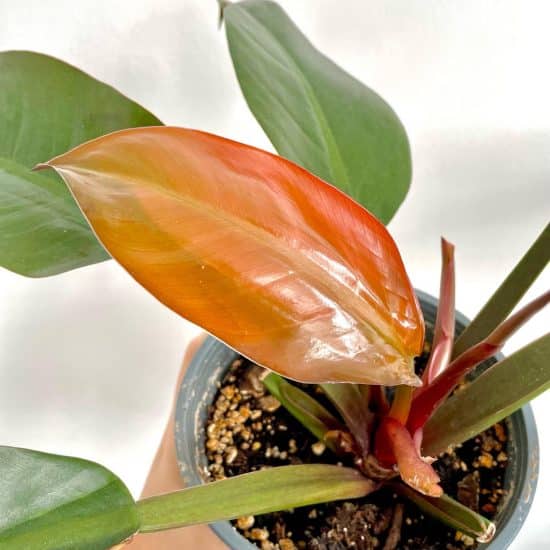
To craft the perfect soil mix for your Philodendron Imperial Red plant, use the following ingredients:
- One-third potting soil. This rich soil base provides your tropical plant with essential nutrients.
- One-third coco coir. This component helps retain the necessary soil moisture while ensuring good drainage to prevent waterlogging and excess water, thanks to the crushed bark.
- One-third DIY succulent and cactus mix. This addition aids in drainage and aeration, preventing plant roots issues and bacterial infections.
Keep in mind, this plant prefers being somewhat root-bound. Philodendron Imperial Red repotting should only take place every two to three years.
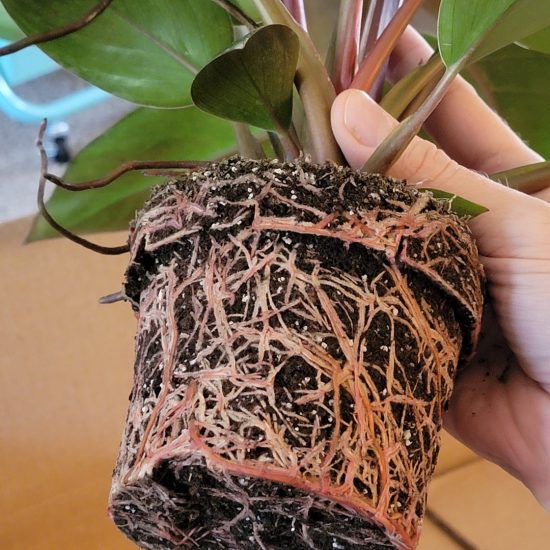
Use fresh soil and ensure the existing pot has drainage holes (this is really important!).
Fertilizer
In early spring, during the growing season, apply a light layer of worm compost and peat moss to feed your Philodendron Imperial Red. Then, use Eleanor’s VF-11 plant food or a similar product four to five times a year, from spring through early fall.
Be cautious not to over-fertilize, as it can damage your plant (think yellowing green leaves and a crusty soil surface).
If you notice signs of over-fertilization, stop feeding and flush the soil with clean tap water.
For monthly Philodendron Imperial Red care, use a diluted fertilizer solution.
Propagation
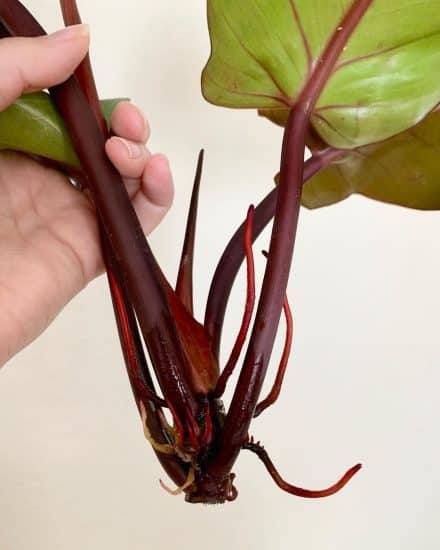
Stem cuttings or air layering are the best methods for propagating Philodendron Imperial Red. You may be less familiar with how to air layer, so we’ll go over that process here.
This involves creating a compact environment for roots to develop on the stem before cutting it away from the mother plant. To get started, gather a plastic bag or plastic wrap, moss, and a sterilized cutting tool.
Propagating Philodendron Imperial Red via air layering:
- Find an active oval-shaped leaf: First, take a close look at your Philodendron Imperial Red and find an oval-shaped leaf that’s actively growing. These leaves will have stiff stems on the plant’s stem.
- Make a shallow cut: Once you’ve picked a leaf, create a shallow cut about one inch above the leaf’s base. Be careful not to cut too deep — halfway through the stem is perfect. This cut will stimulate root growth, given the right conditions.
- Wrap with damp peat moss: Next up, moisten a handful of peat moss and wrap it gently around the cut stem, making sure to cover the area completely. The damp moss creates a humid environment that encourages root growth.
- Seal the moss: Now it’s time to cover the moss with either a clear plastic bag or plastic wrap. Make sure to seal the ends tightly to prevent air and moisture from escaping, creating a mini greenhouse effect around the stem.
- Keep an eye on root growth: Over the next few weeks, watch for root development within the moss. Make sure the moss stays damp by misting it if needed. Once the roots are well-established and several inches long, you can move on to the last step.
- Cut and pot the new plant: When your roots are ready, snip the stem just below the new roots. Remove the plastic wrap or bag and gently separate the moss from the roots. Plant your new cutting into a suitable pot with well-draining potting mix, and treat it like a mature plant with regular Philodendron Imperial Red care.
Our propagation tips:
- Patience is essential: Philodendron Imperial Red propagation can take a few weeks, so don’t worry if roots take some time to appear.
- Maintain humidity: Keep the moss consistently damp, and ensure the plastic wrap or bag is tightly sealed to preserve humidity during the process.
- Watch for mold: Wrapped moss can develop mold if it’s too wet or lacks air circulation. If you spot mold, remove the wrap, clean the area, and restart with fresh moss.
Common Issues
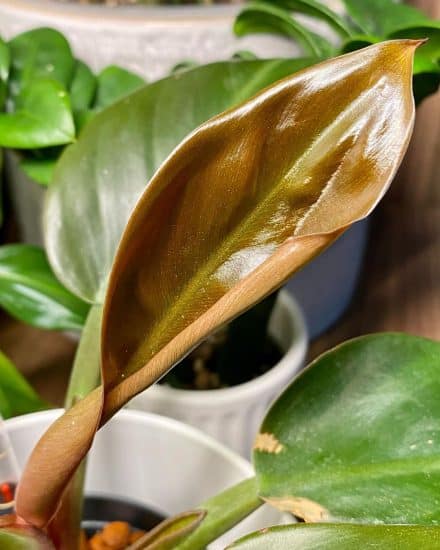
Like any other decorative foliage plant grown indoors, Philodendron Imperial Red sometimes experiences a few common issues.
Brown Leaf Tips
When you notice brown leaf tips on your Imperial Red, it might be a sign of plant burn caused by over-fertilizing. Excess salts in the fertilizer can harm the delicate foliage.
To tackle this issue, ease up on the fertilizer by reducing both the frequency and amount applied (this helps prevent further damage). You should also flush the soil with water, washing away excess salts that may have built up.
Keep a watchful eye on the plant, and trim away any affected leaves to encourage new, healthy growth during the growing season.
Slow Growing, Dusty Leaves
Imperial Red Philodendrons are admired for their large, leathery, oval-shaped leaves, but dust accumulation can lead to slow growth and a dull appearance. Dusty leaves can obstruct bright light (which is essential for plant growth), so cleaning them is crucial.
Gently wipe the leaves with a soft, damp cloth or sponge to remove any dust, and consider making a cleaning solution by mixing a bit of lemon juice with water.
Cleaning your Imperial Red Philo’s leaves not only improves its look but also helps the plant receive more indirect light, which in turn promotes healthier growth.
Pests and Diseases
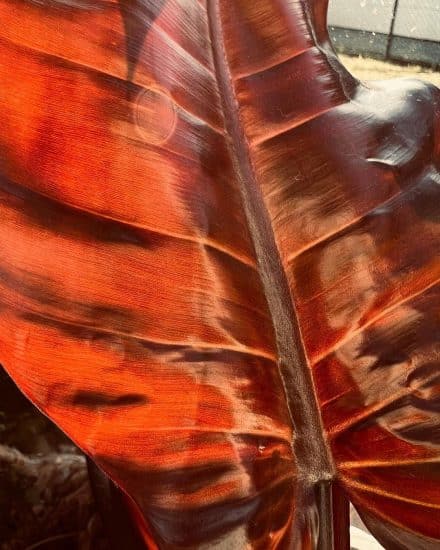
Taking care of your Philodendron Imperial Red is generally a breeze, but occasionally, you might encounter some pesky pests or diseases.
Root Rot
Not root rot! (Don’t worry). This issue affects many tropical plants, including the Imperial Red. It happens when the plant’s roots sit in soggy soil for too long, suffocating them (due to a lack of oxygen) and causing them to decay.
To spot root rot, be on the lookout for yellowing leaves, wilting, and a nasty smell coming from the soil.
If you think your philodendron has root rot, here’s what to do:
- Gently remove the plant from its pot and check out the roots. While healthy roots are white and firm, rotten ones are brown, mushy, and slimy (yuck).
- Snip away the affected roots with sterilized scissors or pruning shears. Be a cleanliness champion and clean your tools before and after this process to avoid spreading the rot.
- Swap out the old soil for a fresh, well-draining mix. Adding perlite or pumice can help with aeration, making it easier for the roots to breathe.
- Be cautious with water — wait until the top two inches of soil are dry before adding more, and make sure the pot drains well to prevent standing water.
Pests
Though the Philodendron Imperial Red doesn’t have unique pest problems, it can still attract the usual houseplant suspects, like spider mites, mealybugs, aphids, and scale insects. These tiny troublemakers often sneak in on other infected plants you bring home.
To keep pests at bay, treat your philodendron to a refreshing spray down at the kitchen sink, helping it stay free of dust, dirt, and insects.
If you spot an infestation, isolate the affected plant (like a plant quarantine), stopping pests from spreading to your other houseplants. Gently wipe the leaves and stems with a damp cloth, removing as many pests as you can.
For stubborn infestations, apply a water and dish soap mix, or use neem oil to treat the entire plant (don’t forget both sides of the leaves).
Keep a close eye on the plant, and repeat treatment as needed until pests pack their bags and leave.
Conclusion
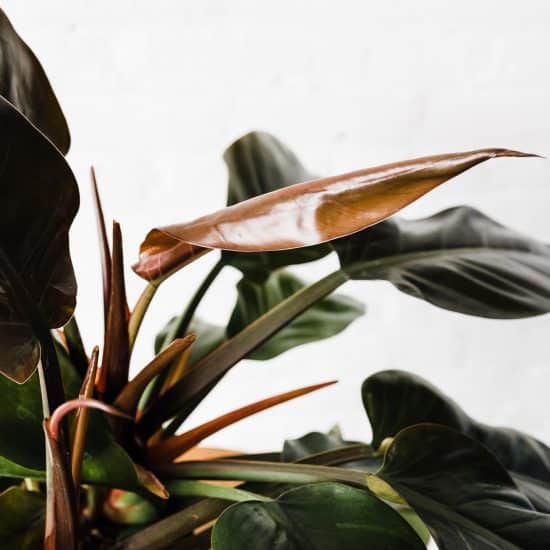
And there you have it, our comprehensive Philodendron Imperial Red care guide!
This stunning houseplant with its glossy foliage and deep red hues is not only a beautiful addition to your indoor garden, but it’s also quite low-maintenance, making it perfect for both seasoned plant enthusiasts and beginners alike.
Philodendron Imperial Red care summary:
- Aim for moderate/medium light exposure, avoiding direct hot sunlight to prevent leaf burn.
- Maintain average home temperatures and humidity levels, ideally between 40-60%.
- Use a well-draining soil mix made of one-third potting soil, one-third coco coir, and one-third DIY succulent and cactus mix.
- Fertilize with a diluted solution monthly, and use worm compost and Eleanor’s VF-11 plant food (or similar) for optimal growth.
- Propagate by air layer to expand your plant collection.
- Repot only after two to three years, since these guys like being root bound!
We hope this guide has provided you with all the information you need to successfully care for your Imperial Red Philodendron.
Don’t hesitate to reach out to us if you have any questions or concerns. Happy growing, and may your home flourish with the vibrant energy of the tropics!
FAQ
Is Red Leaf Philodendron toxic?
Yes, the Red Leaf Philodendron (Imperial Red Philodendron) is toxic to both humans and pets. The plant contains calcium oxalate crystals, which can cause irritation and swelling of the mouth, throat, and gastrointestinal tract if ingested.
Keep the plant out of reach of children, cats, and dogs to prevent accidental ingestion.
Is Philodendron Imperial Red a hybrid cultivar?
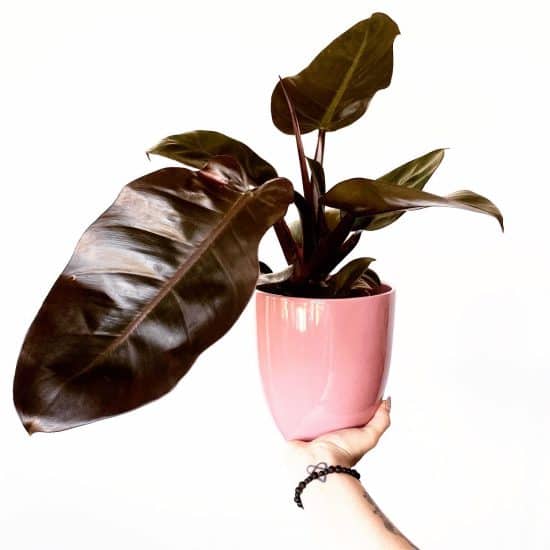
Indeed, Philodendron Imperial Red is a hybrid cultivar. This striking variety was created by crossing two different Philodendron species to produce the stunning red and burgundy foliage that has made it so popular among plant lovers.
Can you cut its aerial roots?
You can safely trim the aerial roots of your Imperial Red Philo if you prefer not to air layer. These roots help the plant gather moisture and nutrients from the air, but they are not crucial for the plant’s survival (especially when grown as a houseplant).
To trim the aerial roots, use clean, sharp scissors or pruning shears and make a clean cut near the base of each root.
However, if you decide to air layer your Imperial Red, keep these roots intact. (Check out the Propagation section above to read more about how to air layer). The aerial roots can aid in the development of a healthy root system in the new plant.
But if you don’t plan to air layer, trimming the aerial roots won’t cause any harm to your Philodendron. Just remember to clean your cutting tool before and after use to prevent the spread of diseases.

